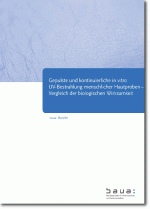Pulsed and continuous in vitro UV-irradiation of human skin samples - comparison of biological effectiveness
(in German)
Biological effects of pulsed incoherent UV-radiation were investigated in biopsies of human skin to identify possible increased health risks in comparison to continuous (cw) irradiation. First, the induction and localisation of DNA damage in the epidermis as well as DNA damage repair and apoptosis were analysed after application of increasing doses of continuous UV-exposure. The data showed a linear dose dependence of CPD induction between H = 0-1500 J/m² (unweighted) for continuous UV-irradiation. Furthermore, a better DNA repair was observed in basal as compared to suprabasal cell layers. The repair capacity of all epidermal cells decreased with rising dose whereas apoptosis increased.
The validity of the Bunsen-Roscoe law could be shown for E = 0.3-3 W/m² concerning CPD induction as well as for E = 1-3 W/m² in terms of apoptosis, only, but not for DNA repair. Therefore, the reciprocity law does not apply for biological endpoints that are based on cellular processes. High repair rates and apoptosis occurred with low irradiances, long durations of experiment and increasing number of applied pulses. There were no differences between pulsed and continuous incoherent UV-irradiation indicating the applicability of the principle of accumulation.
Finally the biological damaging potential of pulsed UV-irradiation was investigated as a function of pulse duration and pulse repetition frequency. The results showed no effect of these pulse parameters on CPD induction and no distinct dependence on DNA repair. However, shorter pulses, lower pulse repetition frequencies, higher numbers of applied pulses as well as longer experiment times gave rise to high amounts of apoptotic cells. Stronger repair capacity of basal epidermal cells compared to suprabasal cells could not be found.
These data suggest no need for a new exposure limit value concept regarding exposure to pulsed incoherent UV-radiation at the workplace. However, the duration of the experiment, irradiance and a variation of pulse parameters seem to have a relevant impact on processing of DNA damage. It needs to be taken into consideration that only a small range of pulse duration, pulse repetition frequency and irradiance were investigated and therefore indications from these results have to be further verified. Additionally the impact of diverse irradiances with varying pulse parameters should be examined.
Please download the complete report "Pulsed and continuous in vitro UV-irradiation of human skin samples - comparison of biological effectiveness" (in German only).
Bibliographic information
Title: Gepulste und kontinuierliche in vitro UV-Bestrahlung menschlicher Hautproben - Vergleich der biologischen Wirksamkeit.
1. edition. Dortmund: Bundesanstalt für Arbeitsschutz und Arbeitsmedizin, 2019. pages: 74, Project number: F 2377, paper, PDF file, DOI: 10.21934/baua:bericht20190329
